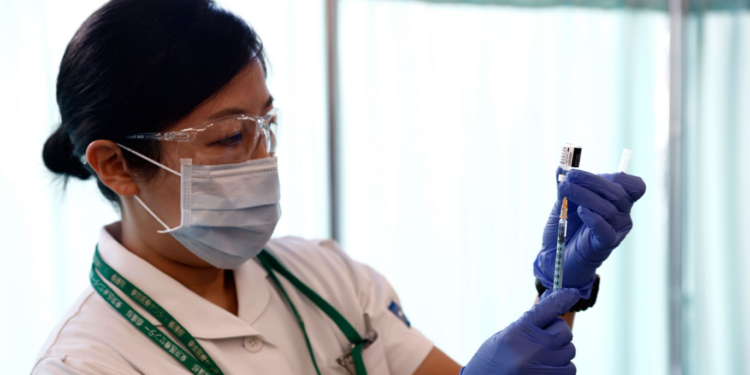In the almost three year-long debate over post-vaccine deaths, vaccine sceptics have often pointed to the clear temporal association between the Covid shots and reported post-vax deaths. In Japan, for example, 70% of reported post-vax deaths of people aged 65 and over (Fig.1) and 64 and under (Fig. 2) who got the Pfizer/BioNTech shots occurred within 10 days of the last dose. Not only does this safety signal shine brighter than all the neon signs in Tokyo but also these reports can only be made by medical personnel and vaccine makers, who can hardly be accused of being biased anti-vaxxers.
This may seem like an open-and-shut case. But regulatory authorities, who have acted as judge, jury and defence lawyer for the mRNA shots, could respond that the close temporal association between reported deaths and the jabs is nothing more than a product of reporting bias: deaths shortly after the shots are more likely to be reported than deaths that occur later even if deaths in both time periods are no different to the background rate. Thus, the mRNA shots can’t be convicted on the basis of the temporal association alone. So what evidence can the prosecution present to prove the mRNA shots are guilty?
Well, if the reported deaths were all coincidental and the temporal association was indeed due to reporting bias, then you’d expect the ratio of male to female deaths to remain unchanged across risk and control periods (although a higher ratio of male deaths would be expected in both since Japanese women live six years longer on average than Japanese men). After all, there’s no reason to think the sex of the dead vaccinee would affect the likelihood of the death being reported in different periods. On the other hand, if the sex ratio significantly differs between the risk and control periods, we can probably conclude that the spike in reported post-vaccine deaths is a genuine safety signal.
This theory is put to the test in a new peer-reviewed paper by Yasusi Suzumura titled ‘Analysis of the Association Between BNT162b2 mRNA COVID-19 Vaccination and Deaths Within 10 Days After Vaccination Using the Sex Ratio in Japan‘.
Descriptive analysis was conducted using data on deaths reported after vaccination with the BNT162b2 mRNA vaccine [Pfizer/BioNTech]. The data used were published by the Ministry of Health, Labour and Welfare in Japan. The risk period was defined as within 10 days of vaccination, and the control period was defined as 11 to 180 days after vaccination. Sex ratios were calculated for all-cause deaths and each outcome by dividing the number of males by that of females and multiplying by 100. [emphasis added here and below]
He further broke the data down into people aged 65 and over (Group 1) and 64 and under (Group 2) and compared causes of death between men and women too.
No country for old women
In Group 1, the sex ratio for all-cause deaths during the risk period was 92, which was significantly lower than the 130 observed during the control period (p=0.0050)… The sex ratio during the risk period was lower than that during the control period for conditions including ischemic heart disease, aortic aneurysm/dissection, intracerebral hemorrhage, subarachnoid hemorrhage, cerebral infarction, interstitial lung diseases, pneumonia, aspiration pneumonia/asphyxia, marasmus and unexplained deaths.

So more women than men were reported to have died in the 10-day risk period (485 vs 448), whereas the opposite was true in the control period. The same finding was found in a previous study but only for Japan and not for Europe or the U.S. So what explains the racist and sexist disparate impact BNT162b2 has on elderly Japanese women immediately after vaccination?
The reasons for the low sex ratios are believed to be that women’s body weight in Japan is generally lower than that in the USA and European countries and that women’s immune responses to vaccines are stronger than those of men.
In a Japanese-language article summarising his study, Suzumura points to this result to bluntly state that “The safety of vaccines in Japan should not be judged based on data published overseas.” Unfortunately, the Japanese Government is now approving vaccines based on next to no safety data from anywhere.
No country for young men either
In Group 2, the sex ratio for all-cause deaths during the risk period was 204, which was significantly higher than the 111 observed during the control period (p=0.044).

In other words, reported male deaths outnumbered reported female deaths by more than two to one in the 10-day risk period (116 vs 57). Anyone who thinks that’s due to chance would be advised to avoid casinos. Intriguingly, men were three times more likely to die in the risk period from cardio-related reasons (49 vs14) and unexplained reasons (28 vs nine). Suzumura appears to think what I’m thinking here.
Since autopsies were performed in only nine of the 51 cases of unexplained deaths, some myocarditis/pericarditis cases may be included within the unexplained deaths category. Myocarditis is a complication of vaccination, especially in young adults and adolescent males. One contributing factor for the high sex ratio of all-cause deaths during the risk period is thought to be the high number of myocarditis/pericarditis deaths including undiagnosed cases.
Nothing to see here?
Much of the rest of the study is dedicated to a long discussion of what statistical techniques are appropriate for discovering and assessing vaccine safety signals, with Suzumura detailing the reasons his technique (self-controlled risk interval design; SCRI) is preferable to that of a previous 184,500-person cohort study that found no increase in all-caused deaths within 21 days of vaccination in Japan in 2021. However, without any peer-reviewers to placate, he expresses himself more clearly in his Japanese article.
If a cohort study does not show a significant difference, the vaccine will be considered safe and vaccination will not be stopped. However, this only means that the incidence of death or serious side effects is not high enough to cause a significant difference; it doesn’t mean that there is “no causal relationship between the vaccine and death or side effects”.
Vaccines are intended for all people, including healthy people, so the mortality rate due to vaccines must be extremely low. Therefore, it is insufficient to assess vaccine safety only with cohort studies that cannot detect significant differences when mortality rates are very low.
A cynic might say that the other researchers chose the technique they needed to get the result they wanted.
The conclusion Suzumura draws from his findings is as expected, but it’s still surprising to see it written so clearly in a peer-reviewed publication.
The present analysis showed significant differences between sex ratios during the risk and control periods for individuals aged 65 years and over and 64 years and under in the reported deaths after BNT162b2 mRNA vaccination in Japan. This finding indicates that the vaccination may influence the occurrence of death during the risk period and might be associated with death.
This article first appeared on Guy Gin’s Substack page, Making (Covid) Waves in Japan. Subscribe here.














To join in with the discussion please make a donation to The Daily Sceptic.
Profanity and abuse will be removed and may lead to a permanent ban.